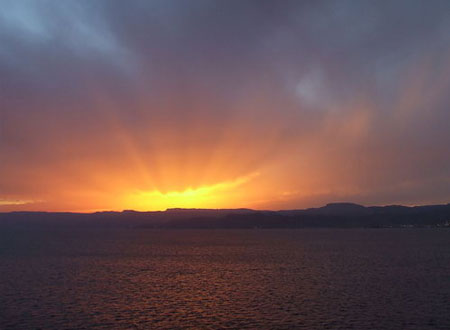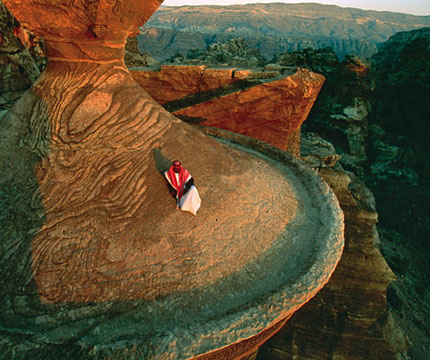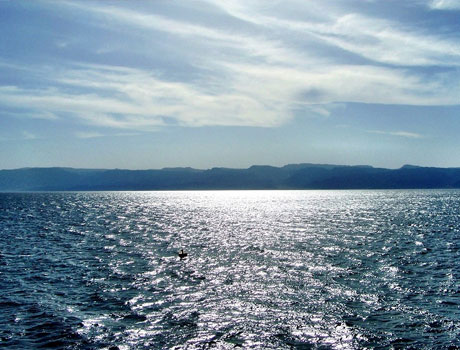Jordan
Country statistics

Land area: 34,286 sq miles (88,802 sq km)
Total area: 34,495 sq miles (89,342 sq km) excludes West Bank
Population (2012 est.): 6,508,887 (growth rate: -0.965%); birth rate: 26.52/1000; infant mortality rate: 15.83/1000; life expectancy: 80.18
Capital City: Amman
Monetary unit: Jordanian dinar
Languages: Arabic (official), English
Ethnicity/race: Arab 98%, Circassian 1%, Armenian 1%
Religions: Islam (Sunni) 92%, Christian 6% (mostly Greek Orthodox), other 2%
Country introduction

Jordan is situated geographically in South-west Asia, south of Syria, west of Iraq north-west of Saudi Arabia and east of Israel and the West Bank; politically, the area has also been referred to in the West as the Middle or Near East.
Jordan has no coast except for 28 km (17 miles) at the tip of the Gulf of Aqaba on the Red Sea. It was called the Gulf of Aqaba after the city of Aqaba, which located in the same area. Almost 80% of the country is arid or semi-arid, with a desert plateau to the west and a high plateau in the east. The Jordan Valley, containing the Jordan River and the Dead Sea, is a deep rift valley, lying largely below sea level. At the Dead Sea, the elevation drops to -411 m (-1,349 ft). Only 4% of the land is arable and less than 1% is covered with trees.
Part of Jordan is mountainous with much of the eastern area of the country consisting of desert. Jabal Ram located in the south is the highest mountain in Jordan with an elevation of 1,734 m (5,689 ft). The Desert to the north east is dotted with oasis and the desert to the south east contains large structures of brightly colored eroded limestone. The ancient desert city of Petra is an ancient rose-colored city cut out of rock. The most famous desert in Jordan is the Rum Desert, home of the wondrous Wadi Rum landscape. Towering sandstone mesas dominate this arid area, producing one of the most fantastic desert-scapes in the world.
A range of small hills run the length of the country in between the Jordan Rift Valley in the west which mainly consists of the hills of Samaria and Judea, and the desert plateau of the east consisting of the hills and escarpments of the plateau's edge.
The Yarmuk River is the largest tributary of the Jordan River, which is 80 km (49 miles) long between Syria and Jordan. Water from the Yarmuk is used for irrigation of the part of the Jordan River valley which is under Jordan's control.
The culture

As a Muslim country, Jordan's culture is quite conservative, although not as conservative as some other Middle Eastern countries. Western influences (particularly in Amman and other large cities) have infiltrated Jordanian society so Jordan now possesses a mix of Arabian customs amid modern ways of life. Due to immigration, Jordan now has a significant Palestinian and Iraqi population, adding to the cultural diversity of the country.
Despite the outside influences, Islamic traditions are strong in Jordan with spectacular mosques signalling the call to prayer five times a day, Ramadan being observed each year and some segregation of the sexes occurring.
The desert-dwelling Bedouin have a distinct culture of their own, drawing on traditions that have been passed down for centuries. Living a largely nomadic lifestyle, the Bedouin rely on the herding of animals and the creation of handicrafts in the absence of a fertile environment to farm. With a strong musical heritage, traditional instruments are played and time-honored traditions are continued.
Music is also important in Jordanian life. Traditional Arabic music is based on a five-tone scale, unlike the Western seven-tone system. The rhythms are elaborate. Songs often tell stories of family, honor, love and death. Most instrumentalists accompany a vocalist rather than playing on their own, and improvisation is common. Some Arabic instruments include the oud (similar to a lute), the mizmarmujwiz or nay (both types of flute), the rababah (a type of violin with one string), and the gerbeh (like bagpipes). Small drums, played on the lap, are used to keep the rhythm. American pop and rock music is popular with younger Jordanians.
Jordan has a remarkable culinary tradition. Halloumi is a traditional cheese made from goat or sheep milk, often served in a sandwich of pita-style bread. Rice, flat breads, legumes, olives, lamb or chicken, yogurt, vegetables and fruits form the basis for most meals. Rice is the major ingredient of several dishes. In a typical meal, a large tray of rice and meat is placed on a covering laid on the floor surrounded by small dishes of yogurt and salad. Tea, Turkish style coffee and juices are served during special visits. Mansaf is the national dish consisting of lamb cooked in dry yogurt.
Attractions & landmarks

Jordan is a land steeped in history. It has been home to some of mankind's earliest settlements and villages, and relics which were left by numerous ancient civilizations from the Sumerians and Babylonians to the Romans and Byzantines. This makes for a diverse collection of historical monuments and archeological sites dotted across the country.
One of the world's greatest archaeological sites is the Nabatean City of Petra, which is nested away in the mountains south of the Dead Sea. The famous city cut out of rock was founded by the Nabataeans in the 6th century BC as their capital city and is Jordan's most popular tourist attraction. Entrance to the city is through the Siq, a narrow gorge, over 1 km (0.6 miles) in length, which is flanked on either side by soaring 80 m (262 ft) high cliffs. Walking through the Siq is an experience to remember, allowing visitors to see the dazzling colours and formations of the rocks. At the end of the Siq visitors will be able to catch a first glimpse of Al-Khazneh (Treasury).
The capital metropolis Amman is probably one of the most visited spots in Jordan among its cities. One of the world's oldest continuously inhabited cities, today Amman is considered among the most sophisticated and westernized cities of the Middle East that attracts a wide variety of visitors who enjoy the city's historic attractions as well as exciting restaurants and nightlife scene. The famous landmarks in Amman are the Roman Theatre, the Ummayad Palace, the Citadel, the Temple of Herakles, and also the Byzantine Church.
Surrounded by rugged mountains that subtly change colour as the day unfolds, Aqaba is Jordan's only port city. It lies on the most northern tip of the Red Sea and on a clear day one can see Israel, Saudi Arabia and Egypt. Aqaba is most known today as a thriving luxury beach resort area that is home to some of the country's best scuba diving and water sports. It is worth visiting the Aqaba Castle and Museum, also known as Mamluk Fort. It was rebuilt in 1587 AD under one of the last Mamluk Sultans. The Aqaba Museum lies adjacent to Aqaba Castle and houses an important collection of the Islamic periods from the mid-seventh to the beginning of the 20th century AD. Marine life enthusiasts can visit the Aqaba Aquarium, which has more than 30 species of stony and soft corals, 30 different invertebrates and about 45 species of reef fish. A simulation of coral reef in the Gulf of Aqaba was created in a roofless concrete tank.
The Red Sea borders the countries of Jordan, Israel and Egypt and is one of the most famous resort areas in the world. A spectacular source of natural beauty and wondrous wildlife, the unique body of water is a noted diving site that has also been the site of expeditions by explorers such as Jacques Cousteau. The Dead Sea has been known as "the Salt Sea", due to its extremely high salinity of 33%, which is approximately 8 times saltier than the ocean. The high salt and mineral content makes it nearly impossible for living organisms to survive and makes it one of the most sought-after ingredients in spa treatments and cosmetic products. The Dead Sea has been known for its healing powers since the time of Herod The Great. Today, Dead Sea spas offer the opportunity to take advantage of the therapeutic benefits of this unique body of water.
Another fascinating city to visit is Irbid, which has the Museum of Jordanian Heritage. The museum attracts many tourists who want to get to know more about Jordanian record and lifestyle. The urban centre also has many shopping areas with large collections of clothing, jewelry, and souvenirs.
Other attractions include the Citadel of Kerak and the Kerak Archaeological Museum both situated in Kerak, the Madaba Museum and the Madaba Archaeological Park, both situated in Madaba.